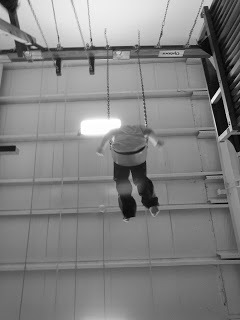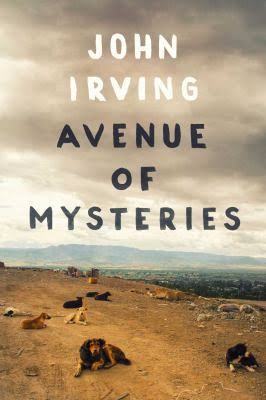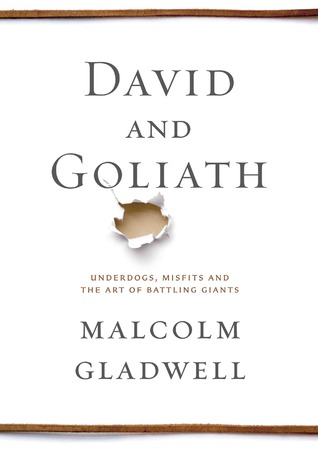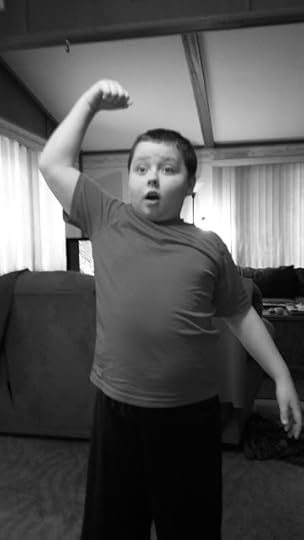Briane Pagel's Blog: Thinking The Lions, page 17
March 3, 2016
OKAY PEOPLE HOLD ON HERE WE'VE GOT SOMETHING TO TALK ABOUT
There is a Cadbury Creme Egg pizza.
THERE IS A CADBURY CREME EGG PIZZA.

The guy who invented it calls it "I Am The ResurEGGtion" and says "Easter is the time to indulge and what better way than to fill your face with pizza and chocolate?"
I am not 100% sure of the correctness of that theology but I am willing to convert nonetheless.
THERE IS A CADBURY CREME EGG PIZZA.

The guy who invented it calls it "I Am The ResurEGGtion" and says "Easter is the time to indulge and what better way than to fill your face with pizza and chocolate?"
I am not 100% sure of the correctness of that theology but I am willing to convert nonetheless.
Published on March 03, 2016 18:35
March 2, 2016
Oh man I gotta learn how to knit.
Want:

WANT:

WAAAAAAAAAAAANTTTTTTTTTT!!!!!!!

I would never ask for anything ever again if I could just have this ONE THING.

WANT:

WAAAAAAAAAAAANTTTTTTTTTT!!!!!!!

I would never ask for anything ever again if I could just have this ONE THING.
Published on March 02, 2016 17:21
But a regular star just so dense at its center that it's fusing atoms into higher elements at temperatures of up to 27,000,000 degrees, no that's just fine.
 Last thing Wedge wants to do is pilot around the edge of a black hole or through the center of a star
going supernova.
Last thing Wedge wants to do is pilot around the edge of a black hole or through the center of a star
going supernova.
-- Aftermath, by Chuck Wendig
Published on March 02, 2016 10:27
March 1, 2016
Hey if you've been leaving comments here
 ... I can't see them. I only just realized this tonight when I was wondering why nobody at ALL had commented on the post, which was low even for my blog, and I checked on my phone and saw all kinds of comments.
... I can't see them. I only just realized this tonight when I was wondering why nobody at ALL had commented on the post, which was low even for my blog, and I checked on my phone and saw all kinds of comments.I tried to reply to them, but had to sign in, and they disappeared. So after a lot of googling, and changing the HTML on my blog, and more googling, and an ice cream sandwich, I'm at a loss. I can see comments if I sign out, but can't reply to them because when I sign in (to reply) they disappear.
If you have ideas, let me know -- you could email me at bfpageljr[at]gmail.com. Or leave it in a comment and I'll sign in and out to read it.
Also, if you have ice cream sandwiches, I'm still kind of hungry.
Published on March 01, 2016 19:59
February 29, 2016
Book 13: Irving is back, baby!
 Back when I read Last Night In Twisted River I gave up on any new John Irving books. Part of my frustration with that book was how the promotion of it involved, repeatedly, people emphasizing how John Irving writes the last line of his books first; so much emphasis was placed on this that I thought the last line of that book must have been pretty phenomenal, almost Gatsby-esque. It wasn't. The other part of my frustration was more complicated but it boiled down to this: Last Night was an okay book, but not a good John Irving book. I expected more from him, and noting that most of his post Garp output had slowly been downhill, I decided I wouldn't read any more Irving.
Back when I read Last Night In Twisted River I gave up on any new John Irving books. Part of my frustration with that book was how the promotion of it involved, repeatedly, people emphasizing how John Irving writes the last line of his books first; so much emphasis was placed on this that I thought the last line of that book must have been pretty phenomenal, almost Gatsby-esque. It wasn't. The other part of my frustration was more complicated but it boiled down to this: Last Night was an okay book, but not a good John Irving book. I expected more from him, and noting that most of his post Garp output had slowly been downhill, I decided I wouldn't read any more Irving.I'm not sure, then, how Avenue of Mysteries made it onto my reading list; I must have read a review or something that sounded like maybe Irving was back to form, so I put it on there, and I wasn't disappointed. While Avenue isn't anywhere near The Hotel New Hampshire or The Cider House Rules or A Prayer for Owen Meany, it's better than a lot of Irving's more recent work has been, and something of a departure for him, too.
Avenue, like most of Irving's books, focuses on a writer in an unusual setting; Juan Diego is a middle-aged writer who at the start of the book is setting out for Manila to honor a promise he made to a Vietnam draft dodger many years ago; Juan Diego is going to visit the grave of the draft-dodger's father, only he doesn't know the draft-dodger's name or his father's name.
The story then alternates between Juan Diego's pilgrimage to Manila and flashbacks (mostly via Juan Diego's very vivid dreams) to his childhood in Oaxaca, where he and his sister Lupe were "dump kids," kids working at the Oaxaca dump and living in a little hut there. Juan Diego's and Lupe's mother is a cleaning woman for the Jesuit orphanage and church and also a prostitute, leaving Juan Diego and Lupe to be raised by Rivera, a man who is "probably not" Juan Diego's father.
From there, Irving piles on a fantastic assortment of Irving characters and plot twists; it's almost as though John Irving set out to write the quintessential John Irving book. So successfully does Irving incorporate nearly every single one of his usual tropes, plots, and themes, that at one point I thought to myself that Avenue is part greatest hits tour, part Irving-mixtape.
A small smattering of what Irving includes will show fans of his what I mean: there is a circus, and the cloud-walker (from A Son of the Circus); there is the transvestite (from Garp), prostitutes (from The Hotel New Hampshire), a priest who wears Hawaiian shirts and whips himself (from A Son Of The Circus), dwarves (ditto), a religious statue that gets broken (Owen Meany), a potential-miracle (ditto), a [spoiler alert] mother dying (Hotel New Hampshire), a child with a hard-to-understand voice (Owen Meany), and so on. Through it all, Irving talks about writing and authorship (including whether autobiography and memoir constitute 'real' writing), religion, family relationships, and a smattering of politics -- this time, the AIDS epidemic of the 80s.
But Irving takes all his familiar ideas and characters and mixes them together very skillfully with some new ideas. He introduces Miriam and Dorothy, mother and daughter who take Juan Diego under their wing as he starts his trip to Manila, and accompany him for parts of the trip. For much of the book, it's not clear whether Miriam and Dorothy are even real, and after a while it starts to be unclear whether Juan Diego's life is real at all -- although Irving clears that up by the end of the book. (And yes, the ending line is again unmemorable. If Irving really writes his last line first, he's wasting his time.)
A John Irving book is like a Wes Anderson film: both are expected in ways that mark them as entirely their creators' own. For the most part, it works this time -- in a way that Twisted River didn't work much at all.
The Oaxaca storyline is the far more engaging of the two sides of the story -- but that's the point, I think. Juan Diego's childhood is so remarkable: in the span of a short time from when the Jesuits discover him, a "dump reader" who has taught himself to read and speak both Spanish and English, through to the time when he actually moves to Iowa -- no spoiler, there, because when we first meet Juan Diego he's in Iowa -- Juan Diego and his sister Lupe -- who can read minds and can tell the future, but whose language is so garbled that only Juan Diego can understand her -- go through a variety of tragicomic events that take them to Mexico City, the circus, and to a phenomenal scene when they scatter their mother's ashes, the emotional climax to the story (or at least the Mexico story). That part alone could have made a phenomenal book.
The elder Juan Diego's journey is less memorable, probably by design. The elder Juan Diego takes beta blockers for his heart and these suppress his adrenaline and imagination; he spends his trip drifting in and out of sleep, spending time with Dorothy and Miriam, and then time with his former student Clark, who is a writer himself living in the Philippines. The trip has a hazy quality to it; all of Juan Diego's life after moving to Iowa is less vivid and more dreamlike than his childhood. I took it as deliberate, a comment that the colorful dramatic part of Juan Diego's life had passed, or at least that Juan Diego saw it that way -- even though the trip itself, and some of Juan Diego's memories of Iowa City are plenty colorful and dramatic themselves.
What's really remarkable is that the Oaxaca parts of the book feel happy and vibrant and joyful, while the Iowa/Philippines parts of the book feel sad and dirgelike -- even though Oaxaca has many more sad things happening, to all the characters, and Iowa City has mostly happy things happening (although this being an Irving book, tragedy strikes about every other page, sometimes right out of left field.)
With Irving, there is always a feeling that the book has one or more messages; Irving is didactic at times and you get a sense that he wants to demonstrate to you how much he knows about even the smallest details of his writing (like the descriptions of the beta blockers). The overall message here seems to hover around Irving's occasional ruminations on fate: Juan Diego is told by Lupe that he has a "different future" and Lupe's predictions, we are told, are not always accurate. Juan Diego, in Oaxaca and the Philippines, has his itinerary mapped out for him -- sometimes literally-- by people he barely knows, who just drop into his life (Miriam is described as "the lady who just appears," rightly), and seems to be someone who is just dragged along in the currents of other people's wakes; this is an odd thing for a kid who was so smart that he taught himself to read two languages, and Juan Diego chafes at how his life goes, both overtly and implicitly: he gets angry at people who expect him to be a certain way, but confused whenever he tries to take over his own life.
I'll have to think more before I decide if there really is a message here, or if Irving is just kicking around ideas and concepts. The book has a more hodgepodge feel to it than many of Irving's books; it feels more jumbled, not quite as planned as his other books. Irving's books read like he wrote them from back to front, with all the pieces falling into place and forming a cohesive whole. This book feels less like that -- and for that reason, a bit more alive than many of Irving's later books have been. Part of that might come from the Mexican settings; when Irving gets away from New Hampshire, he seems to let his imagination run a bit more wild: In A Son Of The Circus, he had a murder mystery that spanned decades alongside a fantastic storyline of a doctor writing screenplays for a hated but popular series of movies. Here, he doesn't quite match that, but the feel is the same (possibly because the two books share so many elements.)
It's interesting that Irving seems more alive and imaginative when he writes about non-New England stories; part of this book talks about the difference between memoir and imagination, and that might have been on Irving's mind as he wrote this book, playing out the arguments in his writing as they were in his head. Either way, this book feels fresher, less contained, more alive, than Twisted River was, and moreso than many of his books.
If you're an Irving fan, especially of his earlier works, odds are you'll enjoy this book. If you don't like Irving or haven't tried him, don't start with this one: check out The Cider House Rules or A Son Of The Circus or The Hotel New Hampshire instead, and if you like them come back to this one.
Published on February 29, 2016 18:53
February 27, 2016
American Cell Phone
The cell phone was patented in 1917 by a Finnish inventor named Eric Tigerstedt. Tigerstedt was often called "the Thomas Edison of Finland." You can tell the two apart, though, because it was Thomas Edison, not Eric Tigerstedt, who lied about the cause of his deafness: Edison, late in his life told people he was deaf because he'd been helped onto a train by a conductor who lifted him by his ears.

Although right now many people are focused on the fight between the FBI and Apple -- and more people don't understand why that fight is important -- it's equally important to note that for over 10 years the FBI has had the ability to remotely turn on the microphone on your cell phone to listen in on you even when your phone is turned off.
Even if the software isn't on your phone right now, it can be remotely installed by the company that made your phone.

Over 60 law enforcement or government agencies in the United States are known to have "stingray" devices -- a tool that simulates a cell phone tower and intercepts (and can record) every cell phone conversation (or data point) passing through it.
Those are the ones that are known. Most government agencies don't let people know whether they have a stingray or not.

Thomas Edison said "Just because something doesn't do what you planned it to do doesn't mean it's useless."
Published on February 27, 2016 18:45
February 25, 2016
Book 12: How the mighty have fallen.
 I came to David and Goliath a bit circuitously. I started reading it last year and got a chapter in before abandoning it for a new book I'd gotten. I only came back to it last week because the loan expired on another book I was reading, and David and Goliath was one of the few audiobooks I was kind of interested in that I could download right away from the library.
I came to David and Goliath a bit circuitously. I started reading it last year and got a chapter in before abandoning it for a new book I'd gotten. I only came back to it last week because the loan expired on another book I was reading, and David and Goliath was one of the few audiobooks I was kind of interested in that I could download right away from the library.It wasn't worth the wait. I've been a fan of Malcolm Gladwell's since I read The Tipping Point; I liked that and Outliers because the way they used anecdotal evidence to examine hypotheses and make arguments about their premises was entertaining as well as thought-provoking.
David and Goliath, though, suffers from too few examples of Gladwell's premise, or from perhaps his stretching it to try to encompass more than the theory ever could. The book is an argument that what we think of as being an underdog is often incorrect -- that underdogs in fact win more often than the title would suggest. Insofar as that goes, the book's first 1/3 or so is a pretty interesting look at why underdogs aren't really. Gladwell examines the David-vs-Goliath story of the title, noting that not only is David's weapon, a sling, a far more deadly weapon than most people assume (it was about the equivalent of a handgun when used properly) but also suggesting that Goliath himself suffered from various physical ailments that while contributing to his large size left him nearly blind and with difficulty moving.
That sets up what seemingly was the premise of the book: that the superior force often hides weaknesses, and the underdog is often only so on the surface. Gladwell then discusses two basketball teams: one, a girls' team in California, the other a mens' college team. Each team had no real skilled players on it, but each managed surprising victories by playing basketball the way it is almost never played: using a full-court press, defending the field from the throw-in to the other end.
Through those two stories, Gladwell's work is at least interesting: he suggests that being an underdog means finding gaps in the way conventions favor the powerful, becoming a disruptive force by finding another way -- not necessarily better, overall, but powerful in its unexpectedness-- and succeeding in that other way.
Then the book goes off the rails, eventually ending dismally, both in terms of the story and in any coherent examination of the idea. Gladwell walks through a terrible example of a rich man discussing the difficulty he has raising his children because he can't teach them the value of a dollar. As a guy who is not rich and who wholeheartedly believes that we should simply allow the government to take away any income a person earns about $200,000 per year, I am not sympathetic to a guy feeling bad because when his kid asks for something he can't simply lie and say we don't have the money. The argument both trivializes the problems poor parents have and completely fails to fit the theory Gladwell spent a few chapters setting up.
Gladwell uses the rich man's dilemma to set up what he calls the "U Curve" of advantage, arguing that as something increases, it eventually hits a point where the advantages level off and eventually fall back to being disadvantages: the rich man finds wealth an advantage, as he gets richer and richer -- but when he gets too rich, it becomes a disadvantage because it poses an impediment to not giving in to his children.
Before getting to why the U-Curve is such a dumb idea, it should be pointed out that Gladwell uses this example to develop his "U-Curve" without explaining what is curving, and with changing the argument. Gladwell did not set up the story in any way that would suggest that the man had an easier time disciplining his kids about money as he got richer, until he hit a point where he couldn't anymore; Gladwell can't, because the man didn't have kids (it seems) until he was already rich. So how would he know whether it's harder or easier to raise kids if you have no money, or a million dollars, or a billion dollars? He's only done it one way -- and Malcolm doesn't provide examples of a poor person who finds it pretty darn easy to teach kids the value of a buck.
The "U Curve" theory is just a bell curve, and the "Bell Curve" theory is one of the dumbest theories that exists. The "Bell Curve" or something similar has been used (in addition to Gladwell's strangely confusing argument here) to artificially lower people's grades, and to alter American economics forever-- among other ill effects.
Grading on a "curve" is terrible: it makes people failures simply for not being as smart as the other people taking the test. In a "curve" grading, you take the best performance and artificially label that an "A." From there you simply spread people down, marking the next lowest a "B" and so on. The problem with this is that it presupposes that everyone cannot get an "A", and also that the best work is an "A."
Consider: 5 people take a 100-question test. Person A gets 100% correct. Person B gets 99, C gets 98, and so on to D (97) and E (96). All of them got fewer than 5 questions wrong -- but Person E fails the test.
What if A gets an 80, B a 75, C a 70, D a 65, and E a 60? Person A still gets an A, down to E, who fails -- even though A did 20 points less in this example.
As the numbers of participants go up the "bell" gets more pronounced, as this theory tries to lump as many people in the middle as possible -- confusing a median that exists naturally with one that is forced into creation.
Grading on a curve isn't as bad as the "Laffer Curve," which continues to infect policy today. Laffer was the one who drew a napkin curve for Ronald Reagan and convinced policymakers that taxes can be too high on the rich and that higher taxes are a disincentive for wealth accumulation. Tax rates were promptly cut for the rich and today the economic imbalance is poised to destroy society.
The highest marginal tax rate in the US in 1979 was 70%; in 1979, a wealthy person would have paid 70% taxes on the very uppermost of his income. In 1979 there were one billionaire and 450,000 millionaires in the United States.
In 2016, the highest marginal tax rate is 39.6%, and applies only to income above about $400,000 per year; the rich pay 39.6% of every dollar they earn above $400,000. There are 536 billionaires in the United States, and 10,100,000 millionaires.
In that time, inflation has about tripled, so a million dollars in 1979 is the equivalent of $3,000,000 in 2016. In other words, thanks to the Laffer Curve, the increase in billionaires has been accelerated by a factor of 536.
I can't think of anything that actually DOES work on a bell curve -- at least not in social policy or psychology. Nobody should argue that a "bell curve" actually makes sense, in any way. Gladwell's is particularly hard to work with. Throughout the book I kept trying to picture the graph a particular 'bell curve' would fit on -- what would be the X axis? What would be the Y? If the X axis is, say, parental wealth, then the Y Axis would be "ease of disciplining children," but how are you going to measure that? Gladwell doesn't explain, and probably can't because "Bell Curves" are not something that actually exist and should not be used to try to explain anything.
That doesn't deter Gladwell from stretching his theory far beyond the breaking point. He examines, cleverly, the difference between smart people at good schools and smart people at what are considered "poor" schools, to note that you have a better chance of getting a good job and a degree if you are a reasonably smart person at a state school than if you are a very smart person at a 'good' school. Gladwell argues that this is due solely to what he calls the "little fish big pond" theory: the very smart are little fish in a big pond at places like Harvard, but are big fish in a little pond at state schools. As a theory, it's too simplistic: it supposes that everyone reacts to competition in the exact same way, with too little evidence of that. It also does not make clear which is the Goliath here: Harvard? Very smart people?
(The assumption that all people react the same way is prevalent throughout the book: Gladwell supposes that all rich kids would not value money, and assumes that all good basketball teams have no way to play against a full-court press. But anyone whose spent time around people, or on Earth, knows that how an individual person reacts is dependent on hundreds, if not thousands, of individual traits. People are unpredictable, as anyone who looks at what Trump supporters actually believe can tell you.)
From there it's even more downhill: Gladwell suggests that people with dyslexia, people who lose a parent, or who lose a child, are all examples of underdogs who owe their successes, in part to the 'disadvantage' of the one big problem in their life. But taking dyslexia and noting that many successful people have it is the same as noting that most US Presidents have been left-handed: So what? The sample size is too small, and by hand-selecting his examples Gladwell deprives them of any scientific worth. He ignores the many successful people who read just fine, and attributes far too many qualities to a simple genesis.
This alone isn't that bad: it's what Gladwell does in his other books, and his articles in The New Yorker: it's more a way of thinking than it is an application of actual science. But here, more than I recall in his other books, Gladwell presents this as gospel. You wouldn't wish your child to have dyslexia, Gladwell says several times in the book Or would you? The book says he doesn't think you should wish that but the impetus of the argument is that, yeah, you should.
It's in the final 1/3 that I lost patience with the book. Gladwell seems to completely abandon David and Goliath and begins talking about power, and whether power can be exercised without legitimacy. He spends chapters on detailed discussions of the Irish troubles in the 1970s and 1980s without any real explanation of why the detail is there. I got the feeling that he was required to hit a certain page count by his publisher, and so he padded it out. The idea of these chapters is that power if exercised without legitimacy is always bad-- but Gladwell provides no true examples of power exercised with legitimacy, and at times confuses the issue with a discussion of people being outsiders. I won't even get into that; it should have been edited out of the book.
Gladwell compares, for his power argument, two families, each of whom had a child murdered. One family, in California, used the event to help spur the famous "Three Strikes" rule in California that imposed a 25-year-to-life sentence on repeat offenders. Gladwell notes that this resulted in a boom in prison population and only a temporary reduction of crime. The other family, a Canadian family, opted not to attempt to do that, instead, making a statement at the press conference when their daughter's body was found to the effect that they were going to try to forgive the man. Gladwell points to the latter family as one that exercised power with legitimacy, but doesn't explain what power they exercised, at all -- or why the same power was exercised illegitimately in California.
Gladwell seems to think that because "Three Strikes" failed as a social remedy, that the man who got it passed had used his power without any legitimate backing from society; that's not true, though: it confuses the end result with the reason for its existence. It's not necessarily correct to judge a decision solely by its outcome. As I like to point out: the decision to go for it on 4th-and-goal in a football game is either a good one or bad one, before the ball is snapped. Making the touchdown doesn't legitimize the call, and missing it doesn't make the call a bad one. Gladwell doesn't explain why "Three Strikes" was an exercise in illegitimate power mongering; he simply compares it to the British overreaction that led to the Irish Troubles without any real linkage.
(The example Gladwell uses of what brought "Three Strikes" to an end is itself an example of fuzzy thinking. The case that led to a public backlash against the policy was one involving a defendant who had stolen a slice of pizza from some kids. The defendant had five prior felony convictions and so was sentenced to 25-to-life. The story was widely reported with such headlines as "Stealing One Slice of Pizza Gets Life Sentence." The actual story was more complicated: Very few of the papers printed what the five priors were. They were robbery, armed robbery, drug possession and "unauthorized use of a vehicle." If the defendant had done those crimes in a different order, it's likely that the public wouldn't have cared: suppose the first crime was the pizza one, and the last was armed robbery. Would the headline "Armed Robber Gets 25-years-to-life" draw much attention? I doubt it. It was not the slice of pizza alone that sent the man to jail; it was that it was his sixth crime, at least five of which were very serious. Gladwell doesn't discuss that much.)
(I should note that I am against "Three Strikes" and mandatory sentencing laws, but that's for another day.)
In the end, David and Goliath would have made a pretty interesting magazine article; by stretching his thesis to book length, all Gladwell did was water it down with a seemingly-random set of arguments about how people rose above their circumstances. It's tempting to say something snarky about Gladwell himself; his earlier nonfiction books have made him something of a Goliath in this field of writing, and his book shows all the supposed frailties of what he argues as a typical Goliath -- while also being equally unsuccessful. It's neither a coherent book nor a particularly good one -- and ends up making the basic idea behind it suffer from a similar lack of coherence and validity.
Published on February 25, 2016 19:00
Mr F, Chair Pioneer
"Invention ... does not consist in creating out of void, but out of chaos." -- Mary Shelley

(That's the bottom of the chair that is supposed to let the chair spin around. But why would you want to spin in a chair when you can just spin?)
Published on February 25, 2016 18:20
February 23, 2016
This is why you don't see [INSERT POPULAR ATHLETE NAME HERE] eating a burrito during a game.
See this commercial?
It's a commercial for something called Rev Wraps and while it is not everything wrong with America, it is a significant part of what is wrong with America.
Rev Wraps are burritos being marketed as health food to help you be a perfect athlete. In case you read that really fast, I will summarize:
Burritos = health food
THIS is America today. I have been seeing commercials for Rev Wraps for about a month now, and they feature young people enduring some terrible workout and having a burrito to get through it. It is the de-healthenizing of America: taking a food and making the COMPLETELY UNSUPPORTABLE claim that it is health food. And it is getting worse all the time.
YEP THAT'S THE BEER SUPERATHLETES DRINK TO STAY SUPERATHLETES. Order me three, Sweetie, I'm going to do a marathon in the morning.
These commercials drive me NUTS, and not least because in my current state of existence a walk in the park nearly kills me. (Seriously; those pictures from the other day were at the end of a half-mile nature trail and I almost had to go to the hospital after slowly walking there and back.) I would LIKE to be able to get back to running and exercising and maybe having at least some of my clothes still fit me and I RESENT THE BEJESUS out of people who think having a beer and a burrito makes them healthy.
THEY DO NOT. Back when I was actually in great shape -- when I finished second in a 5k and when I could run 6 miles in 6-7 minutes per mile, and weighed 172 -- I had a treat for myself every week. Each Friday for lunch after my classes were done, I'd go get myself a gyro, and a pint of Ben & Jerry's, and some sesame sticks. And a Diet Coke. The total meal was about 2,100 calories. I was under no impression that it was healthy. I was under the impression that I'd run 42 miles that week --sometimes more -- and was going to have a treat. When I wanted to actually lose weight -- I went from 270 to 162-- I ate 1000 calories a day, mostly salads and diet soda, and worked out an hour a day. I would allow myself to eat additional calories equal to the amount I'd burned working out. Even after I let up a bit, I would work out extra to work off those calories -- on Saturdays I'd run and go biking or rollerblading or something.
I never had a burrito to get myself up for working out.
I know some people will say Oh, they're selling that beer as a treat the way you had your Ben & Jerry's at the end of the week. Others will say well a burrito has carbs and such so it could be energy.
NO AND NO.
The implicit and explicit message of the beer ad is if you drink this you will be healthier. Michelob is expressly positioning itself as the drink for athletes. They've even started their "extra mile challenge." But alcohol has been found to inhibit muscle repair and growth, It can affect your body's ability to store glycogen, so you won't have energy for your next cardio workout. It's inherently dishonest to suggest that beer is in any way related to being healthier and a better athlete. Beer -- like many recreational foods -- detracts from athletic performance. You will have to work harder if you have a beer after your run -- Michelob's extra mile is what's required to undo the effect of their beer.
And the burrito with it's protein? Let's compare something.
The burrito -- I picked the pepperoni pizza variety -- has 290 calories per 77 grams. That's 3.76 calories per gram.
A Twinkie has 150 calories per 42.5 grams. That's 3.52 calories per gram.
But Twinkies, you're probably thinking, are unhealthy in other ways. They are -- but so are the "Rev" Burritos. Rev has 20g of fat, 9 of which are saturated fats. That's 1 g of saturated fats per 8.5 g of food. Twinkies have only 2.5 g of saturated fats per serving -- or exactly 1/2 the saturated fats per gram (1 g of fats per 17 g of Twinkie.)
Saturated fats, remember, are the bad ones. The American Heart Association recommends no more than 13g of saturated fats a day -- so 1 1/2 burritos exceeds that, while you could eat 6 Twinkies before you crossed the line.
The burrito has 920 mg of salt. Twinkies have 220. Again, on a per gram basis, Revs have 11 mg of salt per gram of food; Twinkies have 5. 2,300 is the max recommended -- so 2.5 Rev burritos, or 10 Twinkies.
While Rev burritos have 13g of protein -- or 5.9 g of protein per gram of food-- Twinkies have 1g per 42.5 grams of food; that's a lot less, but if you ate the maximum 2 burritos you'd get all that bad stuff and 26 grams of protein; you could eat the 10 Twinkies and get 10g of protein -- about 1/2 the protein total for the same amount of bad stuff.
Twinkies, by the way, have about the same protein as a banana. Bananas have only 1 mg of sodium and 0.1 g of saturated fats per banana. If you ate 26 bananas to match the protein of 2 Rev Burritos, you'd end up with 1.3 grams of saturated fat and 2.6 mg of sodium.
I'm not sure if there are young kids out there saying OMG I need to eat a burrito so I can be like whatever athletes are great now -- since Peyton Manning turned out to be a sexual-assaulting jerkoff I'm not sure WHO I can root for anymore -- but as with the beer, it's inherently dishonest to market a pile of sodium and saturated fat as a health food. I seriously considered mounting a class action suit against the makers of REV Burritos for their deceptive advertising. Instead, I'm just sitting here fuming in the dark. But maybe I will. I could be a spokesperson for regular people everywhere, people who don't want to be misled anymore about what is healthy and what is not, people who are tired of having to watch stupid ads like these, people who just want to eat their Twinkies and be left alone. Well maybe not so much that last group. Or mostly them. Whichever. Now I really want a Twinkie.
It's a commercial for something called Rev Wraps and while it is not everything wrong with America, it is a significant part of what is wrong with America.
Rev Wraps are burritos being marketed as health food to help you be a perfect athlete. In case you read that really fast, I will summarize:
Burritos = health food
THIS is America today. I have been seeing commercials for Rev Wraps for about a month now, and they feature young people enduring some terrible workout and having a burrito to get through it. It is the de-healthenizing of America: taking a food and making the COMPLETELY UNSUPPORTABLE claim that it is health food. And it is getting worse all the time.
YEP THAT'S THE BEER SUPERATHLETES DRINK TO STAY SUPERATHLETES. Order me three, Sweetie, I'm going to do a marathon in the morning.
These commercials drive me NUTS, and not least because in my current state of existence a walk in the park nearly kills me. (Seriously; those pictures from the other day were at the end of a half-mile nature trail and I almost had to go to the hospital after slowly walking there and back.) I would LIKE to be able to get back to running and exercising and maybe having at least some of my clothes still fit me and I RESENT THE BEJESUS out of people who think having a beer and a burrito makes them healthy.
THEY DO NOT. Back when I was actually in great shape -- when I finished second in a 5k and when I could run 6 miles in 6-7 minutes per mile, and weighed 172 -- I had a treat for myself every week. Each Friday for lunch after my classes were done, I'd go get myself a gyro, and a pint of Ben & Jerry's, and some sesame sticks. And a Diet Coke. The total meal was about 2,100 calories. I was under no impression that it was healthy. I was under the impression that I'd run 42 miles that week --sometimes more -- and was going to have a treat. When I wanted to actually lose weight -- I went from 270 to 162-- I ate 1000 calories a day, mostly salads and diet soda, and worked out an hour a day. I would allow myself to eat additional calories equal to the amount I'd burned working out. Even after I let up a bit, I would work out extra to work off those calories -- on Saturdays I'd run and go biking or rollerblading or something.
I never had a burrito to get myself up for working out.
I know some people will say Oh, they're selling that beer as a treat the way you had your Ben & Jerry's at the end of the week. Others will say well a burrito has carbs and such so it could be energy.
NO AND NO.
The implicit and explicit message of the beer ad is if you drink this you will be healthier. Michelob is expressly positioning itself as the drink for athletes. They've even started their "extra mile challenge." But alcohol has been found to inhibit muscle repair and growth, It can affect your body's ability to store glycogen, so you won't have energy for your next cardio workout. It's inherently dishonest to suggest that beer is in any way related to being healthier and a better athlete. Beer -- like many recreational foods -- detracts from athletic performance. You will have to work harder if you have a beer after your run -- Michelob's extra mile is what's required to undo the effect of their beer.
And the burrito with it's protein? Let's compare something.
The burrito -- I picked the pepperoni pizza variety -- has 290 calories per 77 grams. That's 3.76 calories per gram.
A Twinkie has 150 calories per 42.5 grams. That's 3.52 calories per gram.
But Twinkies, you're probably thinking, are unhealthy in other ways. They are -- but so are the "Rev" Burritos. Rev has 20g of fat, 9 of which are saturated fats. That's 1 g of saturated fats per 8.5 g of food. Twinkies have only 2.5 g of saturated fats per serving -- or exactly 1/2 the saturated fats per gram (1 g of fats per 17 g of Twinkie.)
Saturated fats, remember, are the bad ones. The American Heart Association recommends no more than 13g of saturated fats a day -- so 1 1/2 burritos exceeds that, while you could eat 6 Twinkies before you crossed the line.
The burrito has 920 mg of salt. Twinkies have 220. Again, on a per gram basis, Revs have 11 mg of salt per gram of food; Twinkies have 5. 2,300 is the max recommended -- so 2.5 Rev burritos, or 10 Twinkies.
While Rev burritos have 13g of protein -- or 5.9 g of protein per gram of food-- Twinkies have 1g per 42.5 grams of food; that's a lot less, but if you ate the maximum 2 burritos you'd get all that bad stuff and 26 grams of protein; you could eat the 10 Twinkies and get 10g of protein -- about 1/2 the protein total for the same amount of bad stuff.
Twinkies, by the way, have about the same protein as a banana. Bananas have only 1 mg of sodium and 0.1 g of saturated fats per banana. If you ate 26 bananas to match the protein of 2 Rev Burritos, you'd end up with 1.3 grams of saturated fat and 2.6 mg of sodium.
I'm not sure if there are young kids out there saying OMG I need to eat a burrito so I can be like whatever athletes are great now -- since Peyton Manning turned out to be a sexual-assaulting jerkoff I'm not sure WHO I can root for anymore -- but as with the beer, it's inherently dishonest to market a pile of sodium and saturated fat as a health food. I seriously considered mounting a class action suit against the makers of REV Burritos for their deceptive advertising. Instead, I'm just sitting here fuming in the dark. But maybe I will. I could be a spokesperson for regular people everywhere, people who don't want to be misled anymore about what is healthy and what is not, people who are tired of having to watch stupid ads like these, people who just want to eat their Twinkies and be left alone. Well maybe not so much that last group. Or mostly them. Whichever. Now I really want a Twinkie.
Published on February 23, 2016 19:10
15,842 new words: Not sure we NEEDED a word for that but thanks English I'm sure it'll come in handy someday.
Published on February 23, 2016 05:51
Thinking The Lions
Do you think people invented "Almond Joy" and then thought "we could subtract the almonds and make it a completely different thing?" or did they come up with "Mounds" first and then someone had a brot
Do you think people invented "Almond Joy" and then thought "we could subtract the almonds and make it a completely different thing?" or did they come up with "Mounds" first and then someone had a brother-in-law in the almond business? And anyway did you ever notice that the almond creates a little mound and that "Mounds" are flat?
I'm probably overthinking this. ...more
I'm probably overthinking this. ...more
- Briane Pagel's profile
- 14 followers




